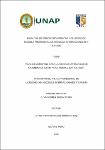Plan de marketing para la venta de artesanías de chambira de la empresa Baraka, Iquitos 2020
Abstract
The general objective of this research was to design a marketing plan to promote the sale of chambira handicrafts from the company Baraka, Iquitos 2020, being an applied study with a descriptive design, the population, made up of a sample of 367 tourists who visited the city, the instrument used was the questionnaire. Therefore, the following conclusions were reached: 46% of tourists make the purchase of jewelry on a monthly basis, likewise, to make the purchase of jewelry they consider the production material (33%), while 24% they focus on physical aspects (color, size and model), and only 19% look at the price. On the other hand, it was possible to identify the SWOT matrix for the sale of handicrafts from the Baraka company. It has been possible to determine the strategies such as the techniques of ancestors, limited training in weaving techniques and the lack of a permanent place for the production of handicrafts; It was possible to determine the easy access to publications on social networks, finally, the low appreciation of handicrafts by internal tourism. In addition, after the internal and external analysis, it was possible to establish the marketing strategies. As well, it has been possible to know the projected budget amounts of the marketing plan. Finally, it has been possible to establish the activities to control the strategies of the marketing plan for the sale of Chambira handicrafts from the Baraka company, 2020. La presente investigación tuvo como objetivo general diseñar un plan de marketing para fomentar la venta de artesanía de chambira de la empresa Baraka, Iquitos 2020, siendo un estudio de tipo aplicado con un diseño descriptivo, la población, conformada por una muestra de 367 turistas que visitaron la ciudad, el instrumento que se utilizó fue el cuestionario. Por lo tanto, se llegó a las siguientes conclusiones: el 46% de los turistas realizan la compra de bisutería de manera mensual, asimismo, para realizar la compra de la bisutería consideran el material de producción (33%), mientras el 24% se fijan en los aspectos físicos (el color, tamaño y el modelo), y solo un 19% observa el precio. Por otro lado, se logró identificar las amenazas y oportunidades para la venta de artesanía a través de la herramienta FODA, teniendo como fortalezas las técnicas de antepasados, asimismo, una limitada capacitación en métodos de tejido y la falta de un local permanente para la elaboración de artesanías; también, se logró determinar el fácil acceso a publicaciones en redes sociales, finalmente, la escasa valoración de la artesanía por parte del turismo interno. Además, tras el análisis interno y externo se logró establecer las estrategias de marketing. Como también, se ha logrado conocer los montos presupuestales proyectados del plan de marketing. Finalmente, se ha logrado establecer actividades para controlar las estrategias del plan de marketing para la venta de artesanía de Chambira de la empresa Baraka, 2020.
Collections
- Tesis [175]


